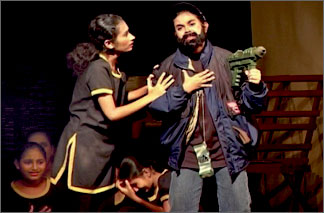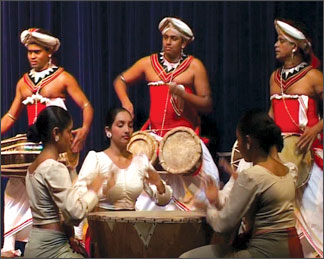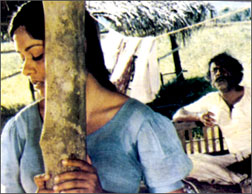Reflections on genuine and original art depict culture
Trinethra cultural pageant:
by Ranga Chandrarathne in Tamil Nadu

“Doothikawo” , exploring a universal theme , Aesthetic quality
incomparable.

Drums of Sri Lanka |
As the Trinethra cultural pageant toured Tamil Nadu, stopping at
diverse educational Institutions, one of the fascinating documentaries
shown and, which is of both educational and artistic value was the
documentary on 'Traditional Drums of Sri Lanka'.
It was the end-result of a meticulous research into the almost
forgotten area of Sri Lankan cultural landscape as traditional drums of
Sri Lanka are diverse in form and shape as well as the purpose they are
used for and for the sounds they produced.
As the living tradition of playing drums vanishes into oblivion, many
traditional drums also disappeared with those traditions, leaving behind
their precious names for their posterity.
History of playing drums in Sri Lanka can be traced back 2500 years
of written history. Different forms of drums have been associated with
the lives of people on various occasions.
Though it has not been established the exact time when drums came
into being, they have been used for entertainment at the inception and
subsequently, the traditional drums became part and parcel of rituals
and were widely used in Buddhist temples. From Tom-Tom beaters to king's
messengers, drums had been played to convey either a degree of the king
or an important official communique to the public.
In addition, there were numerous references to the use of drums on
various occasions in classical Sinhalese literature and the monumental
work such as Pujawaliya (a book of prayers), Thupawansaya (Chronicle on
Buddhist pagodas) and Dalada Siritha (Chronicle of the Buddha's tooth
relic).
The documentary which was shown at the University of Madras, was
well-received by the audience, stirring an informative discourse on the
vanishing traditions of art forms and preservation of them, especially
in a global milieu. It was a soul-searching exercise as the audience
reflected upon their very cultural roots and diverse music an
instruments heired to respective traditions both Indian and Sri Lankan.
Principally there are ten varieties of drums currently used in Sri
Lanka which are different from one another on account of the sounds they
produce and purposes they are used for; Geta Bera (Bera-drum), Yak Bera,
Davula, Thammattama, Udakkiya, Dakkiya, Bummadiya, Hand-held Rabana,
Bench Rabana and Dandu Beraya.
Apart from contributing to improve the understanding of similarities
between Sri Lankan and India art forms, the programme was able to dispel
some of the misconceptions on the part of audience in Tamil Nadu such as
the stereotype ideas that Sinhalese are anti-tamil and war mongers.
These prototype beliefs were reinforced by harrowing tales related by
large number of resident Sri Lankan Tamil refugees in Tamil Nadu, in
addition to misinformation campaign launched by separatists who are
hell-bent on creating an anti-Tamil image of Sri Lanka.
Sympathy on the part of the Tamil Nadu population is understandable
given the close cultural, linguistic and geographical links they enjoy
with their brethren across the narrow Palk Strait. It is Tamil Nadu that
Sri Lankans often visit seeking medical facilities and seek refuge in at
difficult times.
'Doothikawo', children's anti-war drama
The fact that all Sinhalese in the South are not war-mongers and that
there are elements against people who do not advocate war, was amply
manifested following the screening of 'Doothikawo', an anti-war drama
based on terrorist attack on the Chechnyan school which was
script-written and produced by the students of Holy Family Convent in
Kalutara.
The children were prompted to produce the drama as an indirect impact
of the separatist struggle in Sri Lanka and the drama had to be halted
following a threatening letter sent to the Principal of the school by
pro-war-element.
Especially striking dialogues in 'Doothikawo' which were subtitled in
Tamil grabbed the attention of the audience who commenced an interactive
and educative discussion on contemporary Sri Lankan art and culture and
war-mongers in the South who are hell bent on driving a wedge between
Tamil and Sinhala amity.
It was indeed a bridge-building exercise which drives home the fact
that Sinhalese of the South also share a common regional identity amidst
a highly evolved culture.
'Doothikawo' is based on the Chechnyan guerrilla attack on Baseland
College and the crust of the drama is denouncement of war which is a
universal theme. It is obvious that the students produced the drama as a
protest against volatile situation and the war imposed on them by
society.
However, the drama was prevented from being staged following a
threatening letter sent to the Principal by extremist elements in South,
a fact which is being widely discussed in Tamil Nadu.
"Why are we given a gun instead of a pen", one of the striking lines
of the play, epitomises the universal appeal of children caught up in
war. What these children are pleading for is their life, their
childhood, education deprived by war.
It is the fervent cry of children in armed conflicts anywhere in the
world. This message was well received by the intellectuals and scholars
among the predominantly Tamil speaking population.
What was the central theme of the programme is that the medium of art
that it cannot be used to spread a doctrine of violence and to propagate
war. It should be, by and large, reflection of the hope and aspirations
of people celebrating life in its abandonees.
[email protected]
****
On-focused artists in India
|

Anoja Weerasinghe in Muldeniye Simion: an idol glistening amidst
actresses merely because of talents
|
Anoja Weerasinghe is one of the few actresses the Indian audience
know of Sri Lanka. When the 'Trojan Women' was screened in Tamil Nadu,
her mastery in portraying diverse characters was highly acclaimed by the
audience consisting academics and scholars.
She has received Silver Peacock award at the 11th Film festival of
India for the Best Actress for characters Jane and Soma (double acting)
in D.B. Nihalsinghas Maldeniye Simion in 1987.
She has proved her metal in both cinema and drama and even on small
screen. One of her remarkable traits in action is her genuine depiction
of facial expression to suit the changing moods of the character.
Her portrayal of characters in the seminal production of Bertolt
Brecht's 'Mother Courage' as well as Euripides 'Trojan Women' are held
as outstanding performances by an international audience. Tamil Nadu
Governor, Sri Bhishma Narayan Singh awarded Anoja the 'Kohinoor Ratna'
in recognition of her outstanding contribution to cinema.
She was also honoured as the State Gust and conducted three
retrospective Film Festivals in the states of Kerala and Calcutta and
the capital New Delhi.
In addition, a Retrospective Film Festival on Anoja Weerasinghe.
Indian Film directors such as Shyam Benagal, Aravindan and Mani Ratnam
highly appreciate her inborn talent. She is also one of Sri Lanka's
cultural ambassadors. |
